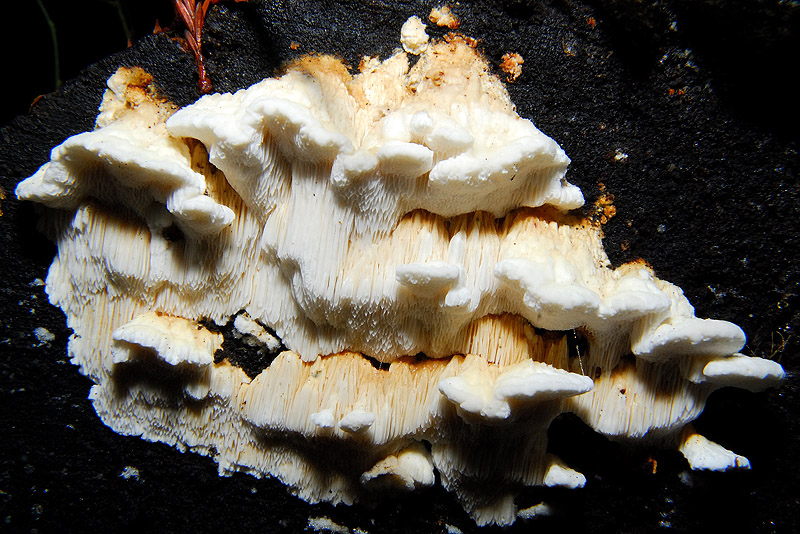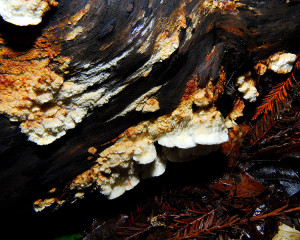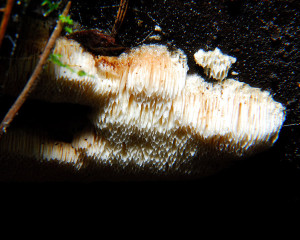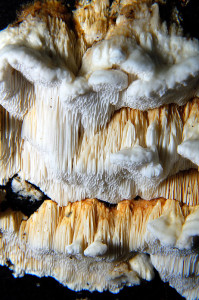The foray into our surrounding woodland last weekend was inspired by our initial sighting of this particular fungus growing over a madrone that had been felled some years ago and left in the woods to decay.
Unfortunately, we don’t yet know much about this fungus, except that it seems to fall into the general category of Polypores in the world of fungi, which includes shelf and bracket fungus. The remarkable thing, at least to me, is that this particular fungus seems to preferentially favor growing on madrone, an otherwise relatively insect and decay-resistant wood.
After careful examination of this fungus, it is clear that it takes on many forms during its various life-stages. It initially appears as a rust-orange hued irregularly textured mat.
Some small, seemingly less developed areas show a honeycomb-like tubular pore structure.
The more mature sections show that these tubules appear to branch from the base, which is typically colored more rust-orange, becoming paler toward the tips. The length of these pores seems highly variable.
The base, at least in more complete specimens, also seems to develop a semicircular shelf-like structure.
The region of woodland where this fungus was observed is relatively undisturbed, with a significant amount of fallen fir, oak, and bay, in addition to madrone. Despite careful examination of other fallen trees in the area showed that this particular fungus species only seemed present on two other madrone trunks, both downed trees. It was not found on living specimens, nor on any other tree species.
We attempted to identify this species ourselves, however, various mycologic keys left us more confused than when we started. We emailed some very high resolution versions of these images to a number of individuals, in the hopes that someone more expert than ourselves in the field of mycology may recognize our mysterious, albeit beautiful fungus. Thus far, it seems the most likely genus for this fungus may be either Spongipellis or Pycnoporellus. There are images in the CalPhotos database of a species identified as Spongipellis pachyodon that appears very similar to this fungus, and was also photographed growing on madrone. However, a microscopic and chemical analysis of our fungus will be the only way to determine its true identity. If anyone has any insights as to what our perplexing polypore may be, we’d certainly love to hear from you!
We’ve barely scratched the surface, but over the course of this week we’ve tried to show you that fungi come in many different shapes and sizes. You’ve now seen some examples of gilled mushrooms, corals and clubs, jelly fungi, puffballs, and a polypore. Although this wraps up our ‘mushroom week’ at Curbstone Valley, winter is far from over. If we find some more particularly interesting species in the coming weeks, we may have to resort to a few extra ‘Mushroom Monday’ posts in between our garden updates. In the meantime, next time you’re walking through the woods, don’t forget to look DOWN, you never know what you might find growing on the forest floor.
















Perhaps it’s a new species you can name Curbstoneii clareicans… It is beautiful, though- like groupings of icebergs!
😀 I agree with the iceberg appearance. It also reminds me of a mineral deposit that you’d be more likely to see in a cave…sort of stalactite-like!